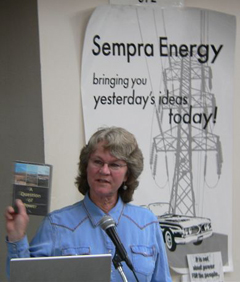By Miriam Raftery
 |
| Sign expresses residents' outrage over fire dangers posed by Powerlink |
April 8, 2009 (Alpine)—A coalition of more than 600 people packed the community center in Alpine last night to protest Sunrise Powerlink, the high-voltage line that SDG&E plans to build through the heart of this mountain community. Attorney Michael Shames from the Utility Consumers Action Network told the crowd that despite approval by the California Public Utilities Commission in December, he believes that construction of Powerlink will ultimately be halted through legal action.
He revealed that as early as 2005, legal strategists mapped out a gameplan for “how to destroy this line” by building a case that would stand up in court. “What’s happened so far is eminently predictable,” Shames said, noting that Governor Arnold Schwarzenegger and former Vice President Dick Cheney were the chief proponents of the line and that four of the five CPUC commissioners were political appointees of Schwarzenegger. Half a million dollars has been set aside to appeal the CPUC decision in court, said Shames, who predicted, “The courts will overturn this.”
The project could also be stopped by any one of three federal agencies: the U.S. Forest Service, the Bureau of Land Management, or the Fish & Game Department. Shames urged citizens opposed to Powerlink to donate funds for local groups to wage legal battles on the federal front. He noted that the two administrative law judges for the state have already issued an opinion sthat the line should not be built. “That carries a lot of weight with the courts,” he said.
 |
| Dulzura resident was among 600 people protesting Sunrise Powerlink in Alpine |
One local group, Backcountry Against Dumps (BAD) is currently fighting to overturn the BLM’s approval of Powerlink in January. Donna Tisdale, founder of BAD, urged citizens to contact local elected officials who she called “Missing in Action” on the Powerlink issue, including Congressman Duncan Hunter, Assemblyman Joel Anderson, Senators Barbara Boxer and Diane Feinstein, and State Senator Denise Ducheny. She also faulted Congressman Bob Filner for not taking action, though Filner has expressed opposition to the project. “He calls this the Deathlink, but where are the letters?” Tisdale asked.
Supervisor Dianne Jacob, the one politician who has been outspoken in her opposition to Powerlink, received a standing ovation. “I’m here to tell you this fight is far from over,” she said. “It is unconscionable to me that SDG&E and the PUC would move forward with something that could increase the danger of another major fire.” She accused SDG&E of “dirty motives” and called for the cost of Powerlink to be invested in putting solar on rooftops instead. “That would put SDG&E out of business,” the Supervisor said. “I would love it. Wouldn’t you?”
 |
|
Donna Tisdale speaks before a poster depicting Powerlink and an Edsel--and suggesting both are antiquated ideas.
|
Jacob revealed that she has spoken with the U.S. Forest Service director. “He is inclined to let legal measures play out before making a decision,” she said.
SDG&E has argued that Sunrise Powerlink is necessary to meet the region’s future electrical needs. But Phil Powers, author of a smart energy plan, presented a point-by-point rebuttal to the utility company’s contentions. “Southern California has one of the densest transmission lines in the country—enough to provide more than 100% of our power. What we lack is local power,” he said.
The utility has made presentations to the public representing that the line would carry energy from renewable sources such as wind turbines and solar farms. But when asked by the CPUC to guarantee that a percentage of energy from Powerlink would be from renewable, SDG&E refused.
Powers said that investor-owned utility companies “privatize profits and make the public take the risk. They have every incentive to build more—and the biggest profits are in construction of lines.”
He revealed that he participated in a survey along with SDG&E that found San Diego could have the capacity to obtain 2,000 megawatts of power from putting solar on commercial buildings, 3,000 MW from solar on residential homes, and 3,000 MW from solar over parking lots. “There would be no environmental issues, no endangered species impact, and it’s the cheapest option,” he concluded, “but SDG&E has tremendous political clout.” By contrast, other cities are turning to photovoltaics in partnership with utilities, he noted. “It would cost twice as much for the same amount of power from the line as to generate solar power here on our roofs.” Moreover, Powers said that due to new energy efficiency standards put in place by the CPUC, “demand for power is going down.”
Area residents carried protest signs and many testified with concerns that included increased fire danger, destruction of views, health dangers including increased leukemia risks for people living near power lines, and decreased property values. One speaker cited a Wall Street Journal aricle which found that property values near high voltage lines declined by 10 to 30%.
Laura Cyphert of Lakeside spoke out against SDG&E’s plan to run the power lines through El Monte Valley, a designated scenic area. “We’re going to lose it forever,” she said, drawing boos from the crowd when a photo of the valley with the power line photo-shopped in was revealed.
 |
|
Stop Sunrise Powerlink coalition turned out a crowd of over 600 April 7th in Alpine |
A Cedar Fire survivor who lives along the El Monte Valley attested, “I was burned out and am just now looking to rebuild a garage. I lost pretty much everything…I had to prove that my building was not going to distract from this breathtaking view…It’s the same view the Kumeyaay Indians saw…a thousand Cedar Fires couldn’t destroy it – until SDG&E came along.”
Others pointed out that the line is slated to travel through old-growth forest that has not burned in many years. An EIR report found that the line presents a high fire danger and that the risk cannot be mitigated. Given that SDG&E has admitted in documents to the CPUC that its lines have caused 167 fires in five and a half years, many residents fear that Powerlink could cause another disastrous fire—or prevent firefighters from battling blazes near the lines even if caused by another source.
Residents also object to intrusion into their rural way of life. “I stood underneath the Southern Route and listened to the crackling,” one woman said. “Instead of birds and frogs in these quiet places, this is what you will hear.”
Alpine residents also objected to 18 months of construction along Alpine Boulevard, where lines are scheduled to be undergrounded, and noted that businesses would be adversely impacted.
Citizens were urged by event organizers to contact the U.S. Forest Service as well as local and national political representatives. “Let them know this is a voting issue for you,” one organizer urged the crowd, adding that if representatives don’t take action to oppose Powerlink, citizens should tell their political leaders that “we won’t vote for you.”
Tisdale agreed with Shames on the ultimate fate of the project. “These decisions will not stand up in a court of law, but we need to fight this,” she concluded, urging residents to help fund additional legal actions. “SDG&E tends to underestimate the power of the people when they put their hearts and their minds and their spirits—and their wallets—into it.”
View a video of the full meeting, courtesy of Citizens Oversight Projects, here: http://video.google.com/videoplay?docid=-4438778231091340584











Recent comments